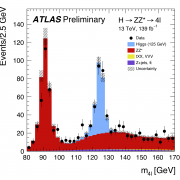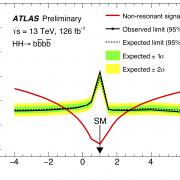Access to Collaboration Site and Physics Results

Theories, such as supersymmetry, propose the existence of new types of particles to explain important questions about the universe, such as the nature of dark matter. ATLAS has performed a search for one such type – exotic heavy particles that have lifetimes long enough that they travel partway through the detector before decaying, at what is called a displaced vertex. At this point these particles, which are produced in pairs, each decay into a photon, and another hypothesized heavy particle, which does not interact with the detector but instead can be identified by the large amount of missing energy in the reconstructed collision. Thus events with these new heavy particles can be identified by the missing energy, and the existence of two ‘signal’ photons created at vertices displaced from the collision point.
The analysis uses the full ATLAS data sample of 8 TeV (tera electron volts) proton-proton collisions delivered in 2012 by the Large Hadron Collider (LHC), and exploits special capabilities of the ATLAS electromagnetic calorimeter, the detector element that absorbs the photons and measures their energy. The calorimeter is finely segmented, and provides fine-grained information about the pattern of a photon’s energy deposition.
In order to identify the signal photons as coming from this type of decay, firstly they must be what is called ‘non-pointing’, meaning they do not point back to the original proton-proton collision point, but instead to a displaced vertex. Using the information from the electromagnetic calorimeter, it is possible to measure the direction of the photon, and to extrapolate it back towards its point of origin to determine whether it is non-pointing. The analysis uses the variable Dzg, defined as the difference, measured parallel to the beamline, between the collision point and the point where the photon path is closest to the beamline. Photons produced in the main collision are a source of background, and should have a value of Dzg near zero, measured with a precision of about 15 mm. Signal photons should have typically much larger values of Dzg.
The calorimeter, with its fast electronic readout, also has excellent time resolution, measuring a photon’s arrival time, tg, with a precision of about 0.3 nanoseconds (1 nanosecond = 1 billionth of a second). The second way to identify the signal photons is by finding that they are ‘delayed’ in that they arrive in the calorimeter with a delay of up to a few nanoseconds, compared to background photons produced immediately in the original collision.
The analysis uses measurements of both Dzg and tgto search for evidence of non-pointing and delayed photons. As shown in the figures, the measured distributions agree well with the expectations for background, and no evidence was found for the signal sought. The results of the analysis are interpreted to provide constraints on the theoretical models predicting such phenomena.
Links:
- Additional material
- High-resolution images: left and right








